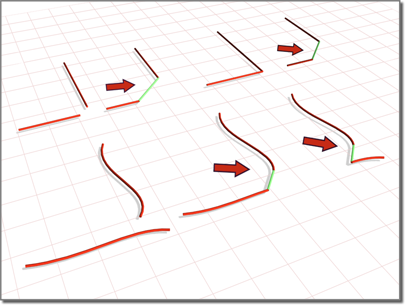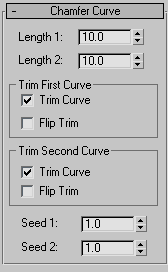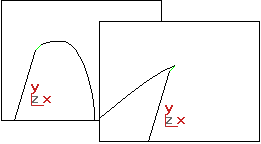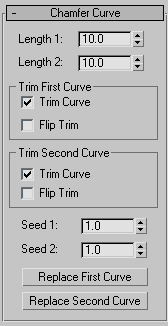![]()

Creating chamfers between two original curves
Procedures
To create a chamfer curve:
- In the NURBS toolbox, turn on
 (Create Chamfer Curve). Tip: Make sure the curves intersect before you begin to create the chamfer.
(Create Chamfer Curve). Tip: Make sure the curves intersect before you begin to create the chamfer. - Click one curve near the end that you want to connect. The end that will be connected is highlighted. Without releasing the mouse button, drag to the end of the other curve that you want to connect. When the end that will be connected is highlighted, release the mouse button.
A chamfer curve is created. Changing the position or the curvature of either parent curve can change the chamfer as well.
The parent curves must be coplanar. The chamfer is not necessarily connected at the endpoints of the parent curves: you can adjust its position with the chamfer's Length parameters.
- Adjust the chamfer parameters.
The NURBS object must contain at least two curves.
Interface
Chamfer Curve rollout (creation time)

The lengths are the distances from the intersection (or apparent intersection) at which the chamfer segment is drawn.
- Length 1
-
The distance along the first curve you click.
This parameter is animatable.
- Length 2
-
The distance along the second curve you click.
This parameter is animatable.
Some length values make it impossible to construct the chamfer. If you set the length to an invalid value, the chamfer returns to a default position and is displayed in the error color (orange by default).
Trim First Curve and Trim Second Curve groups
These two groups let you control how the parent curves are trimmed. The controls are the same in each. "First" and "second" refer to the order in which you picked the parent curves.

Flipping the direction of a trim
- Trim Curve
-
When on (the default), trims the parent curve against the fillet curve. When off, the parent isn't trimmed.
- Flip Trim
-
When on, trims in the opposite direction.
- Seed 1 / Seed 2
-
Change the U location of the seed value on the first and second curves. If there is a choice of directions, the direction indicated by the seed points is the one used to create the chamfer.
Chamfer Curve rollout (modification time)

The lengths are the distances from the intersection (or apparent intersection) at which the chamfer segment is drawn.
- Length 1
-
The distance along the first curve you click.
- Length 2
-
The distance along the second curve you click.
Some length values make it impossible to construct the chamfer. If you set the length to an invalid value, the chamfer returns to a default position and is displayed in the error color (orange by default).
Trim First Curve and Trim Second Curve groups
These two group boxes let you control how the parent curves are trimmed. The controls are the same in each. "First" and "second" refer to the order in which you picked the parent curves.

Flipping the direction of a trim
- Trim Curve
-
When on (the default), trims the parent curve against the fillet curve. When off, the parent isn't trimmed.
- Flip Trim
-
When on, trims in the opposite direction.
- Seed 1 / Seed 2
-
Change the U location of the seed value on the first and second curves. If there is a choice of directions, the direction indicated by the seed points is the one used to create the chamfer.
- Replace First Curve and Replace Second Curve
-
Let you replace the parent curves. Click the button, then click the curve to replace the original first or second curve.
